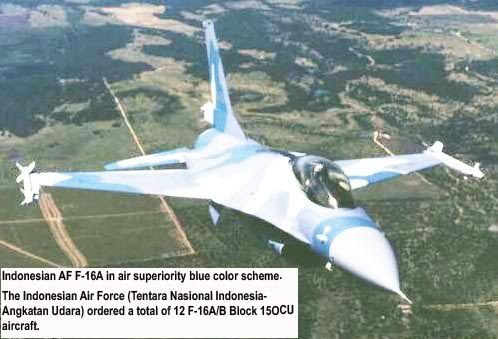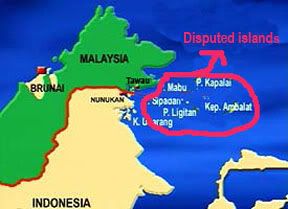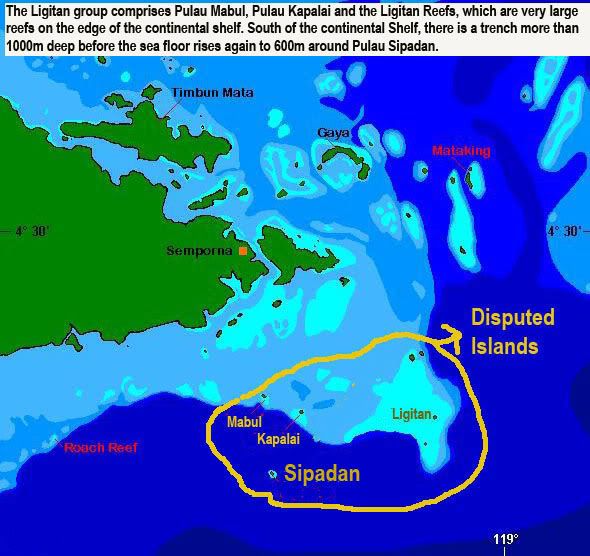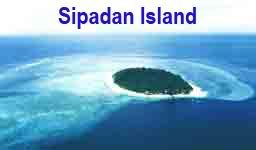
Indonesia's F-16s are employed in both air defense and ground attack roles.
(Photo courtesy of Defense-Technology News)
Indonesia has dispatched an F-16 fighter, and its ground crew, to an airfield in Makassar, on nearby South Sulawesi island, to defend the nearby AMBALAT region (between Sipadan and Ligatan Islands) from Malaysia, which claims ownership of the place.

The area is believed to contain large gas and oil deposits.
The 1982 Law of the Sea gives whoever owns these uninhabited rocks rights to fishing, and oil drilling, for over three hundred kilometers from each of these tiny bits of land.
Aside from prestige and possible historical ties, the primary reasons countries are claiming ownership of these uninhabited bits of land has to do with the ability to control sea lanes, defining maritime economic zones, possible tourist dollars in some instance, and oil, rumored to underlie much of the area.


Two years ago, warships from both countries confronted each other in the area, with a Malaysian ship ramming an Indonesian one, causing minor damage to both vessels. Malaysian warships have been chasing Indonesian fishing boats out of the area. Both nations have awarded oil concessions to companies, but no one is willing to search for oil until the diplomatic, and military, friction is taken care of.
This claim has always seemed most likely to cause trouble in the near term.
On 17th December 2002, the International Court of Justice ruled (16 to 1 votes ) that sovereignty over Pulau Ligitan and Pulau Sipadan belongs to Malaysia.
Read here
RELATED ARTICLE
Background on the Dispute over Ambalat Region between Malaysia and Indonesia
(Read here in Harvard Asia Quarterly for more )
Volume IX, No. 4. Fall 2005
Energy Security and Southeast Asia: The Impact on Maritime Boundary and Territorial Disputes
by
Dr Clive Schofield and Dr Ian Storey
Indonesia and Malaysia’s dispute over part of the Celebes (Sulawesi) Sea off the east coast of Borneo (Kalimantan to Indonesia), termed “Ambalat” or the “Ambalat offshore area”, emerged in February-March 2005.
The dispute came to prominence as a result of the issuing of exploration licenses for two deep-water oil concession blocks, ND6 and ND7, by Malaysia’s national oil company Petronas to its own exploration arm, Petronas Carigali, in partnership with international oil giant Royal Dutch/Shell Group on 16 February 2005.
The Malaysian blocks largely overlap with a brace of Indonesian blocks, the Ambalat block and East Ambalat block, which were licensed to Italian oil major ENI and US-based oil multinational Unocal, in December 2004. The dispute is therefore directly linked to issues of energy security in terms of securing seabed hydrocarbon resources for each state.
The Indonesian Ministry of Foreign Affairs termed Malaysia’s action “a violation of Indonesia’s sovereignty” and warned Shell to stay out of Indonesian waters. Malaysian Foreign Minister Syed Hamid Albar reacted by observing that while Kuala Lumpur had indeed received the protest note, Malaysia had itself despatched similar protests to Jakarta over the concessions the Indonesian authorities had issued to ENI and Unocal.
As diplomatic relations soured, both sides rushed to deploy military forces to the ill-defined disputed area. On March 3, Indonesian President Susilo Bambang Yudhoyono ordered the military (Tentara Nasional Indonesia – TNI) to protect Indonesian sovereignty and secure the disputed area, and it was announced that three Indonesian naval vessels were already patrolling the disputed zone.
Indonesia’s Eastern Fleet Task Force was then gradually reinforced, eventually bringing the Indonesian Navy’s presence up to eight vessels supported by four F-16 fighter jets which were reposted to Balikpapan in East Kalimantan on March 7.
Malaysia argued against military escalation with Foreign Minister Albar, stating that Malaysia “will not do anything beyond what we consider as our rightful maritime area in line with the law of the sea. To me, there is no need to send ships”.
Nonetheless, Royal Malaysian Navy (RMN) and marine police vessels were reportedly deployed to the disputed area, and on March 4 the Malaysian media announced that the Royal Malaysian Air Force (RMAF) had reinforced its units based in Sabah and Sarawak. Subsequently, as diplomatic talks proceeded (see below), the number of Indonesian military vessels in the disputed area was halved, matching the number of Malaysian patrol boats, though suggestions of a “withdrawal” on Indonesia’s part were denied.
The inherent dangers involved in having rival naval vessels in close proximity to one another, both engaged in patrolling what they regard as ‘their’ maritime space and in a context of strained bilateral relations was amply demonstrated by the collision between Indonesian naval vessel KRI Tedung Naga and Malaysian patrol boat KD Rencong, which caused minor damage to both vessels.
Indonesian military sources accused the Malaysians of ramming the Indonesian naval craft. However, Indonesian Navy Chief Admiral Salamet Soebijanto commented that the incident occurred when the Indonesian vessel “tried to drive the Malaysian vessel out of our maritime territory”, indicating a robust, confrontational approach from the TNI.
The incident provoked an emergency meeting between Indonesian President Susilo Bambang Yudhoyono and his top military commanders, whom he instructed to refrain from confrontation, so as to allow the two governments to continue their search for a peaceful diplomatic settlement. Malaysian governmental sources also called for calm, with Malaysia’s Deputy Prime Minister and Defence Minister Najib Razak stating on April 12 that the navy had been told to “exercise restraint” and adhere to strict rules of engagement, while fellow Deputy Prime Minister Datuk Najib declared that it was not Malaysia’s intent to “edge towards conflict”.
Nonetheless, both sides declared their intention to continue their patrols in the disputed area in order to emphasize their claims. While each claimant’s navy has been instructed to patrol only their ‘own’ waters, the fact remains that an area of overlapping claims exists, bringing the two sides’ naval vessels into close proximity, thus raising the possibility of further incidents occurring.
The dispute has therefore witnessed repeated claims and counter-claims regarding violations of national sovereignty, multiple diplomatic protests, and an alarming military build-up in the disputed area. Furthermore, in Indonesia the dispute has been characterized by popular anti-Malaysian street protests, flag-burnings and inflammatory nationalist commentary in the media. Why has the dispute aroused such passions, especially in Indonesia?
What’s at stake? Energy security and Ambalat
The disputed area, though in deep water, is clearly promising, especially in a commercial environment driven by record crude prices. This factor, combined with advances in drilling technologies, has driven exploration efforts in deep and ultra-deep offshore regions, making areas such as Ambalat attractive where previously interest had been limited.
ENI reportedly drilled two test wells in the Ambalat area in late 2004 and made “encouraging” discoveries, leading the Indonesian authorities to provide a very broad estimate of the hydrocarbon deposits in the Ambalat area of between 100 million barrels and one billion barrels of oil.
Although caution should be used in respect to such estimates in the absence of in-depth exploration work, particularly test drilling, it seems clear that there is significant potential for offshore oil and gas exploitation in the Ambalat offshore area, which is of obvious national interest to both states, especially in the context of the energy security dilemmas they face.
The disputed area is also significant in terms of navigation security, as it lies athwart the SLOC running from the Lombok Strait between Bali and Lombok islands northwards via Indonesia’s designated Archipelagic Sealanes through the Makassar (or Macassar) Strait between the east coast of Borneo and the Molucca Islands in the Celebes Sea.
Although much attention has been focused on the Malacca Strait, which is unsurprising since it is estimated to take about 72 percent of eastbound tankers from the Persian Gulf to East Asia, the Lombok/Makassar route is of nearly equal importance from an energy security perspective. This is because while the Malacca Strait dominates in terms of numbers of tankers, the Lombok/Makassar route takes fewer but larger vessels so that in tonnage terms the split between the two routes is roughly even.
Beyond the oil factor
Although securing access to seabed resources and, to a lesser extent, the strategic dimensions of controlling important sea-lanes are important drivers in the dispute, they do not tell the whole story. The domestic dimensions to the dispute, particularly for Indonesia, cannot be ignored. Ambalat represents the first territorial challenge that the new Indonesian President has faced, and as such has been regarded as a test of his statesmanship and resolve on the sensitive question of national sovereignty.
President Yudhoyono has therefore been subject to considerable internal political pressure to take a hard-line position against Malaysia. His ordering of the rapid Indonesian military build-up in the region, coupled with statements declaring the non-negotiable nature of Indonesian sovereignty whilst simultaneously calling for a negotiated peaceful resolution to the dispute, reflects the pressures faced by the Indonesian president.
To some extent, the posturing of both sides also serves domestic political ends. This is especially the case in Indonesia, where the media has been swift to latch on to the dispute as a vehicle to promote patriotic fervor, which has served government interests by distracting public attention from the controversial and unpopular fuel price hikes, averaging 29 percent, implemented from March 1, 2005.
In a sense, therefore, Ambalat has proved a useful pressure valve for the government from domestic concerns. The furor over Ambalat is reminiscent of President Sukarno’s Konfrontasi campaign of 1963-1965 against the newly created Federation of Malaysia. The issue resulted in popular anti-Malaysian demonstrations around Indonesia, where Malaysian flags were burnt and volunteers trained to ‘protect national sovereignty’ and ‘crush Malaysia’.
The upsurge in anti-Malaysian sentiment in Indonesia, promoted by inflammatory media coverage, is surprising in the context of the two countries’ friendly bilateral ties. The Ambalat issue has arisen, however, at a time when bilateral relations have been strained as a result of Malaysia’s crack-down against illegal migrants as of March 1, 2005.
Many of the estimated one million illegal workers in Malaysia are Indonesian. Considerable ill-feeling has been generated by Kuala Lumpur’s actions, particularly those viewed in Indonesia as Malaysia’s heavy-handed tactics including the imprisonment and whipping of illegal workers prior to deportation. Such actions have prompted Indonesian perceptions, fed by lurid media coverage, of their country and compatriots being humiliated and dishonoured at the hands of ‘Malaysian arrogance’.
In contrast, the Malaysian media has proved largely quiescent on the issue, and Kuala Lumpur has urged the Indonesian media to tone down their coverage, as Malaysia had no desire to debate the issue via the media.
All in all, the maritime boundary dispute reflects not only energy security or resource issues, but also the health of the overall bilateral political relationship between the parties. Therefore Ancel’s dictum regarding land boundaries seems just as apt in relation to maritime boundary disputes:
Il n’y a pas de problèmes de frontières. Il n’est que des problèmes de Nations. [There are no boundary problems. There are only problems of nations.]Competing claims
As previously noted, the Ambalat offshore area is located in the Celebes Sea, off the east coast of Borneo. It is worth noting in this context that no land territory is at stake, although several erroneous media reports claimed that Indonesia and Malaysia were contesting sovereignty over “Ambalat Island”.
Unlike the South China Sea island disputes, the Ambalat dispute is non-territorial in nature, and the parties are concerned not with sovereignty per se, but with their overlapping claims to continental shelf and EEZ within which they have specific sovereign rights.
The precise dimensions of the dispute are, however, unclear. While there is unmistakable overlap between competing oil exploration concessions, the dispute extends beyond that confined area. The problem is that while both states have signed and ratified the LOSC and claim 12nm territorial seas and continental shelf and EEZ rights out to 200nm, only one of the parties has defined the extent of its jurisdictional claims.
In 1979 Malaysia issued an official map illustrating the extent of that country’s jurisdiction over territorial sea and continental shelf. Malaysia’s own oil concessions, and thus at least part of the area that Indonesia considers part of its own Ambalat offshore area, fall within Malaysia’s 1979 claim line in the Celebes Sea.
For its part, Indonesia has yet to specify the precise extent of its continental shelf/EEZ claim. But Indonesia does point out that it, along with a number of Malaysia’s other neighbors, rejected the 1979 Malaysian map.
The closest Indonesia has come to articulating its claim was in the case of the International Court of Justice (ICJ) concerning Sovereignty over Pulau Sipadan and Pulau Ligitan. In that context, Indonesia claimed that the maritime boundary should proceed due east from the terminus of the land boundary on the east coast of Sebatik Island which is divided between the two states.
Indonesia hasn’t yet specified the revised scope of its claims in the aftermath of the ICJ case.
Implications of the Pulau Sipidan and Pulau Ligitan case
Malaysia’s claims are at least partially based on the fact that on 17 December 2002 the ICJ ruled that sovereignty over the islands of Sipadan and Ligitan, which are located in the vicinity of the Ambalat area, rested with Malaysia.
The key factor which led the ICJ to award sovereignty to Malaysia, the Court having rejected both sides’ arguments concerning treaty-based title to the islands, was the fact that Malaysia was able to demonstrate the stronger case in terms of effectivités – acts of administration demonstrating effective exercise of authority over the islands.
In particular, Malaysia was able to refer to measures taken by colonial British North Borneo (now Malaysia’s Sabah Province) authorities to regulate and control the collection of turtle eggs on the islands, as well as their construction of lighthouses on Sipadan and Ligitan in 1962 and 1963 respectively, and the subsequent operation of these lighthouses by Malaysian authorities post-independence.
Crucially, the Court noted that when these activities were undertaken “neither Indonesia nor its predecessor, the Netherlands, ever expressed its disagreement or protest”. Indonesia’s effectivités, based on the presence of the colonial Dutch and Indonesian navies as well as Indonesian fishermen in the vicinity of the disputed islands, proved less convincing.
The ICJ therefore concluded, by 16 votes to one, that on the basis of effectivités, “sovereignty over Pulau Ligitan and Pulau Sipadan belongs to Malaysia.”
Malaysia is likely to argue that the maritime boundary should be determined on the basis of equidistance, giving full effect to Pulau Sipadan and Pulau Ligitan.
However, although the ICJ determined sovereignty over the islands, NO maritime boundary was defined.
Thus while Indonesia reluctantly accepts that Sipadan and Ligitan belong to Malaysia, Jakarta is likely to claim that these small islands are nothing more than mere rocks within the meaning of Article 121(3) of the LOSC.
Indonesia is therefore likely to contest their right to generate anything more in terms of maritime jurisdiction than a 12nm broad territorial sea, and not extended claims to continental shelf or an EEZ. Defining a maritime boundary line is therefore likely to hinge on reaching a compromise over the legal status of these features and their potential impact on an equidistance-based delimitation.
It is worth noting that the Sipadan and Ligitan case still resonates in Indonesia, and this factor contributes to the intense Indonesian reaction to the Ambalat dispute. The loss of territory is keenly felt by any state but especially by Indonesia, still smarting after the violent separation of East Timor in 1999.
The reaction has been exacerbated by the fact that the Indonesian government and media did not prepare the public for the possibility of defeat, so that the loss was largely unexpected, especially after considerable investments were made in hiring international lawyers and experts to support Jakarta’s case.
The possible loss of isolated, peripheral islands has provoked serious concern in Indonesia, given that the Indonesian archipelago is made up of an estimated 17,000-plus islands of which only about 3,000 are inhabited.
Although most Indonesian islands are safely located within the country’s archipelagic baselines, this situation has led to worries over potential loss of territory due to neglect and the Indonesian Navy’s inability to mount a real presence, let alone provide effective enforcement throughout such a vast archipelago.
One response prompted by the Sipadan and Ligitan case has been a lighthouse-building campaign.
Indeed, Indonesia has announced its intent to construct 20 lighthouses in the Ambalat area alone. But it is worth noting that construction of a light beacon on Takat [Rock] Unarang on the fringes of the disputed zone was interrupted by Malaysian forces at the outset of the dispute on 20 February 2005, when Indonesian construction workers were arrested and later released.
Dispute resolution
Despite the initially ominous signs of military build-up, heightened tensions between rival navies in the disputed zone and confrontational rhetoric, there have been encouraging signs on the diplomatic front, with both sides calling for calm and moving to deescalate the situation, for example by ordering their militaries not to take any provocative action.
The two countries’ leaders discussed Ambalat by telephone on 7 March 2005 and agreed to resolve the dispute in a “cordial manner” (Badawi) and “amicably” (Yudhoyono). The Foreign Ministers of the two countries, Hassan Wirayuda of Indonesia and Syed Hamid Albar of Malaysia, subsequently met for urgent late-night talks on 9 March 2005 and agreed that both sides would “take necessary steps” to ease tensions and establish technical teams to meet on a regular basis in order to manage and ultimately resolve the dispute.34
The technical teams duly met for the first time behind closed doors in Bali, on 22-23 March 2005.35 Subsequently, negotiations have taken place on a regular basis every two months, alternating between states, as follows: on 25-26 May in Langkawi, 25-26 July in Yogyakarta and 27-28 September 2005 in Johor Baru.
Little information has emerged from these meetings into the public domain, although both sides have agreed to negotiate on the basis of the LOSC, and continue to hold meetings until at least January 2006.
There are strong reasons to believe that a diplomatic resolution to the dispute will eventually emerge. First among these factors is the fact that a negotiation process is underway, and for all their need to address domestic patriotic sentiments, both leaders and governments have repeatedly stated that a peaceful resolution is sought.
For example, President Yudhoyono has stated explicitly that the dispute should be settled peacefully, “without falling into the trap of confrontation, especially armed confrontation”.The two countries also have a strong, friendly bilateral relationship to build on. Both are members of the Association of Southeast Asian Nations (ASEAN) and signatories to that organization’s 1976 Treaty of Amity and Cooperation, meaning that both are formally committed to the peaceful resolution of disputes.
Additionally, they share common religious, linguistic, historical, and cultural traditions. Moreover, the two sides have too much to lose economically were the dispute to escalate. Indeed, on March 23, Rafidah Aziz, Indonesian Minister of International Trade and Industry, declared flatly that the Ambalat dispute “will not affect trade relations”.
As for the final shape of any agreement, this is, unsurprisingly, difficult to predict given the confidential nature of the bilateral negotiations. Nonetheless, both states have considerable experience in negotiating maritime boundary agreements and thus significant ‘in-house’ expertise and capacity. Additionally, there is a wealth of relevant regional and global state practice to draw upon.
The likelihood of Indonesia agreeing to submit the dispute to the ICJ is, however, remote, given Jakarta’s experience in the Sipadan and Ligitan case.
One option that may be worth considering in this context is the possibility of establishing a maritime joint development zone instead of a formal boundary line.
This could represent a viable alternative and means to cooperatively access the desired resources without prejudice to either side’s claims and without undue delay, thus effectively shelving the boundary and territorial dispute. This method may ultimately be applied in the Ambalat area, although Indonesia has, at least initially, stated its preference for a demarcation line solution.
No comments:
Post a Comment